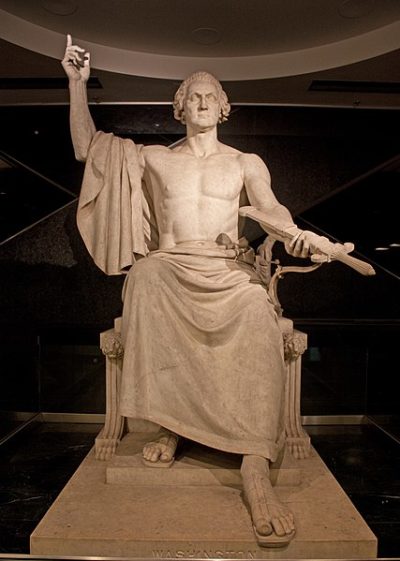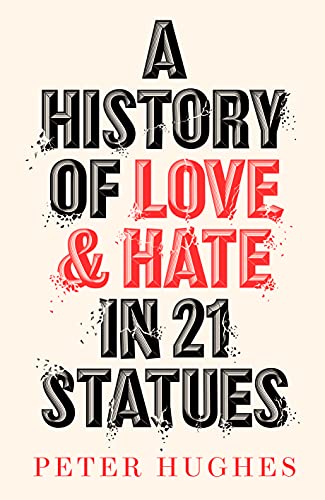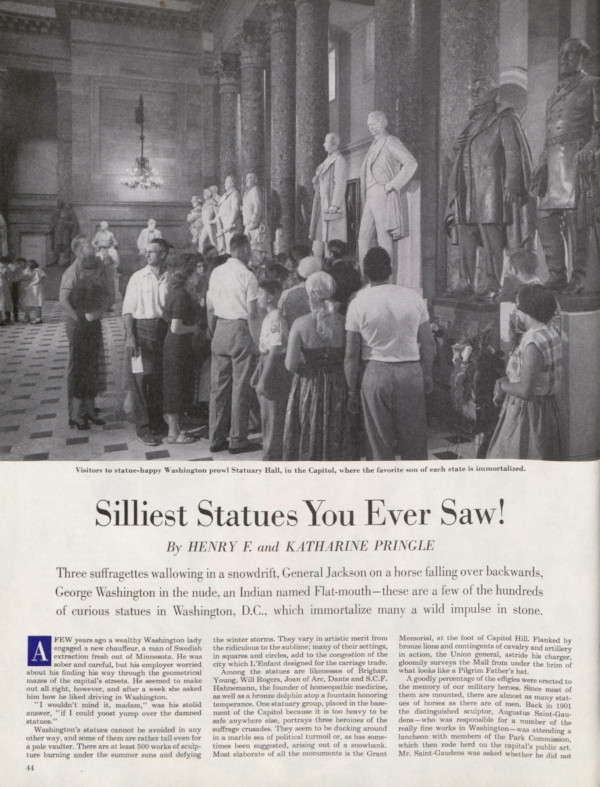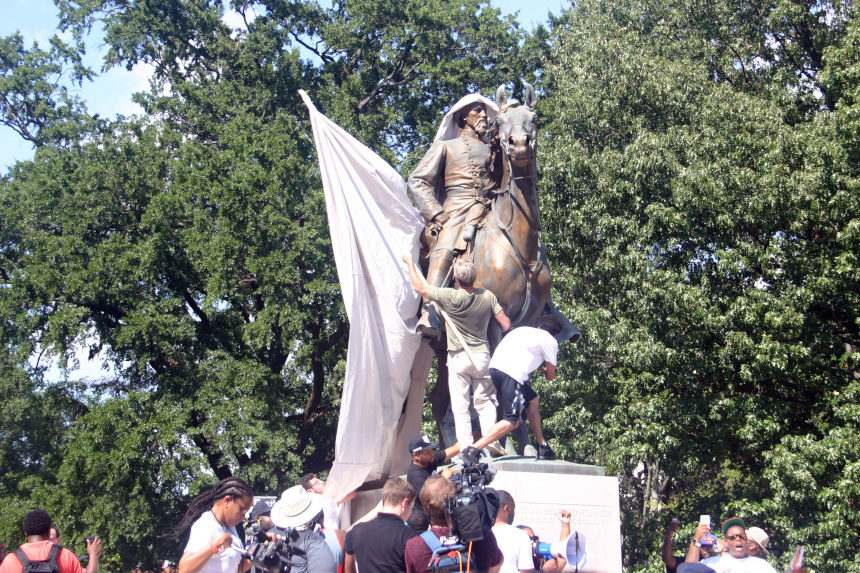In 1841, Americans demanded the removal of a statue of George Washington, which showed him seated, holding out a sword, God-like and half naked. Attacked as disrespectful, tasteless, and comical, the statue was moved out of the Capitol Dome to its east lawn. Then moved down the street to the Patent Office. Then finally brought inside the Smithsonian Institution, where it now sits, all 12 tons of it, as an object of curiosity in its Museum of American History.

The angry response to “Enthroned Washington” shows how deeply Americans feel about statues. They represent not just the features of men and women, but also their principles and morals. It’s why Black activists, in the wake of George Floyd’s murder, tore down statues of the Confederate soldiers who fought to perpetuate racism.
Now, a new book examines the long history of statue-smashing. A History of Love & Hate in 21 Statues is filled with historical and moral perspectives on iconoclasm. Author Peter Hughes spent some time discussing his book with the Post.
Jeff Nilsson, The Saturday Evening Post: Why do you think there’s been a surge in statue-toppling in the past few years?
Peter Hughes: Statues stand as symbols of collective identity. When societies lose a sense of common purpose and fragment into warring groups, those symbols will be attacked.
As the culture wars have intensified, especially in the United States since the killing of George Floyd, there’s been a rapid growth in attacks on statues. The targets range from contentious Confederate monuments to a statue of the Black abolitionist and orator Frederick Douglass.
Many of the attacks are part of a broader assault on American identity and its core values of free speech, due process, and merit. If left unchecked, increasing polarization will lead to social collapse. For decades the West has looked at the disintegration of other societies, especially the Soviet Union, and imagined it couldn’t happen to us. But it can and it is.

It’s one of the ironies of the current situation that it’s the more privileged members of American society that are driving the war on American culture. There are many reasons for this, but one of the main ones is elite overproduction. There are simply too many, mainly white, highly educated people facing an uncertain future, and their anger gets diverted into protesting against real and imagined injustice where they can regain the status they have lost. Statue destruction is just one of the effects of this process, and it’s symptomatic of the direction educated elites are driving political and cultural discourse.
SEP: What do people hope to gain by pulling down statues?
Hughes: On a political or cultural level, people who topple statues hope they are paving the way to a better world.
When we assess whether those who tear down statues get what they hoped for, we need to understand that ideology is a screen for the psychological gratification and status that comes from virtue signaling. Iconoclasts may not get the brave new world they convinced themselves they were fighting for, but the struggle gives them permission to be cruel in the name of “justice.” That cruelty yields the deep satisfaction that comes from expressing dominance over those who were once dominant over them.
SEP: Is destroying statues more about intolerance than correcting history?
Hughes: We need to understand the psychology of conflict.
From the perspective of those who fight, every war is a war of self-defense. The same psychology applies to the destruction of statues. The activists who destroyed a statue of Christopher Columbus in Venezuela, like the mob who destroyed the statue of George Washington in Portland, believed they were fighting against intolerance.
They saw these historical figures as symbols of patriarchal power, colonialism, and oppression. They believed that if society is to progress, these men, along with many others, have to be torn off their pedestals and cast into the dustbin of history.
However, this is extraordinarily naïve.
As the historian Simon Schama observed, “asking for the impossible is one good definition of a revolution,” and when the promised utopia fails to arrive, the revolution gets bloodier. In 1792 when a mob tore down the statue of the French King Louis XV it took less than six months for them to execute his grandson, Louis XVI, on the same spot. By the summer of 1794, Maximilien Robespierre, the architect of the Terror, had himself been guillotined.
Iconoclasts and revolutionaries may believe their motives are pure, but when you hack at the body, real or symbolic, of your enemy, failure to realize your dream of an ideal society leads to deepening spirals of violence and intolerance.
Once we understand the intolerance at the heart of violent acts committed in the name of tolerance, we will be able to dispense with the naïve optimism of the French revolutionary activist Madame Roland. Like many activists, she believed “there must be blood to cement revolution.” She was right. In November 1793, she, like the king, was beheaded in the spot where the statue of Louis XV once stood.
SEP: What about the destruction of Nazi monuments and statues, which was carried out after World War II? Was the destruction of those statues justified?
Hughes: After the defeat of Germany during the Second World War, the process of de-nazification began. It stretched from purging libraries of fascist books to the execution of leading Nazis. It also involved the destruction of statues. Yet, in the 1950s more than a third of Germans still believed the Nuremberg trials were unfair, and it wasn’t until the 1960s that Germans began to confront, rather than bury, their past.
Today, there are no Nazi statues on German streets. There are, however, exhibitions designed to remember Germany’s past and encourage visitors to engage with that past. A 16th century fortress on the outskirts of Berlin contains statues and memorials from Germany’s imperial past, including artifacts from the Nazi era. In another part of Berlin, on the site of the former Reich Security Main Office, there is now a permanent exhibition of statues and symbols from the Nazi era. There are also philosophers and historians such as Susan Neiman who have drawn parallels between the removal of Nazi and Confederate statues.
However, the rise of the AfD (Alternative for Germany), a far-right party, which now holds 94 seats in the Bundestag, clearly shows that Germany has not repudiated its past. If we are to avoid a repetition of past intolerance, what matters most is not the fate of the statues but an understanding of how illiberal regimes, of the left and right, come to a position of ascendancy.
In every case from Maoism to Nazism, illiberalism feeds off grievance and combines the primacy of group identity with the collectivization of guilt. If, then, we are to remove statues, it cannot be done in a spirit of triumphalism. As Kobie Gouws, a South Africa legislator, observed about the removal of statues after the end of Apartheid, “You don’t heal an old wound by making a new one.”
SEP: Rather than destroying statues, should we move them someplace where they can be viewed as historic artifacts instead objects of public veneration?
Hughes: Statues can only be viewed as historical artifacts if they are stripped of emotional relevance.
In England, after the killing of George Floyd, the statue of Edward Colston, a slave trader, was pulled off its plinth, dragged through the streets and thrown into the harbor. The City Council fished it out and placed it in a museum still covered in paint and surrounded by Black Lives Matter placards.
Predictably, the ideological battles around the statue continued. An organization called Save Our Statues planned to block book tickets to the museum so that no one could view the statue. They demanded that Colston be reinstated on his plinth, condemning the “mob rule” that removed him. On the other side of the argument, white, middle-class progressives demanded that Marvin Rees, the black mayor of the city, apologize for slavery. He grasped the brutal irony of the request and replied simply, “It’s a little bit more complicated than that.”
And it’s that complexity that people want to erase.
When people in the present identify with the past, conflict will only deepen if we stand in judgement on them and condemn them for stupidity or malevolence. Pluralism and the right to cause offense are essential components of liberal democracies. The ethos of free expression that sits at the foundation of open societies has always served to protect minorities and will continue to do so. Only the powerful benefit from censorship, and when we tear down our statues, we descend into simple binaries (Us and Them, Black and White, Good and Evil), which fuel our tribal instincts. This is what we must counter. It is wiser to support the retention of statues whose meaning we deplore and use that tolerance to build bridges with those who stand against us.
SEP: As I read it, you believe that destroying statues puts off the forgiveness and dialogue we’ll ultimately need to reduce intolerance. Could you elaborate?
Hughes: At the end of the American Civil War, Abraham Lincoln chose to be magnanimous to the defeated Confederacy. He allowed the defeated soldiers to return home without fear of prosecution for treason. He even allowed them to keep their horses. He did this because he knew the path to reconciliation would be closed if he humiliated his beaten enemy.
Nelson Mandela applied the same logic when he was released from prison and brought the white supremacist regime in South Africa to an end. Only the most offensive statues were removed. “We must,” he said, “be able to channel our anger without doing injustices to other communities. Some of their heroes may be villains to us. And some of our heroes may be villains to them.” This awareness of a shared humanity, with all its flaws and imperfections, enabled Mandela to forgive. If he had turned victory into an orgy of self-righteousness, he would have judged his enemies harshly and became a very cruel leader.
Only by seeing ourselves in the other person and seeing them in us, can we build a tolerant, humane society. Martin Luther King Jr. wrote that “there is some good in the worst of us and some evil in the best of us.” Destroying statues is often a means to deny that fact. It places evil in the other person and all the good in us. That is the engine of intolerance, the tribal psychology hardwired into our biology. It’s as natural to us as breathing. It’s also deeply unforgiving. The triumph of liberal democracies has created societies where character matters more than race, tribe, or nation, and we abandon that extraordinary, improbable achievement at our peril.
SEP: What would you say to an activist who is about to pull down another statue?
Hughes: Understand yourself before you try to change the world.
Featured image: Protesters try to cover up a statue of Nathan Bedford Forrest in Memphis, TN (Shutterstock)
Editor’s Note: This interview has been altered to use American spelling throughout.

Become a Saturday Evening Post member and enjoy unlimited access. Subscribe now




Comments
This is about the removal of statues from wherever. To begin with, I do not believe that anyone in this day and age gives any credence to any concept that a statue conveys any ascendancy over anyone else. They are there just to give honor to someone who was involved in whatever event to the extent that he/she might have had to give up their life for the furtherance of a cause. End of the story–that is past and only becomes part of the history involved. I am 89 years old now, and have never thought of myself as being superior to another person in any way, shape, or fashion. I have had and still have friends from just about every race of people on the face of the earth. You can tear down statues , and burn books or whatever, but the only way that you will ever change a persons attitude or belief about another person or belief will be to change that persons heart through conversion, nt by beating them physically. We are and will be what our inner heart expresses to the world.